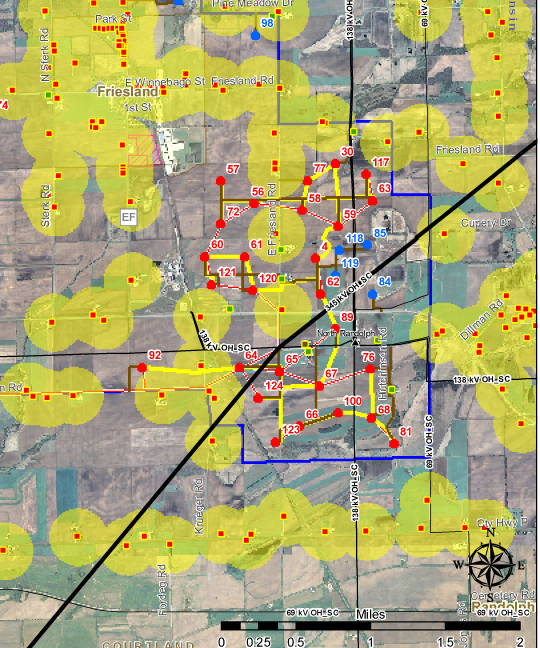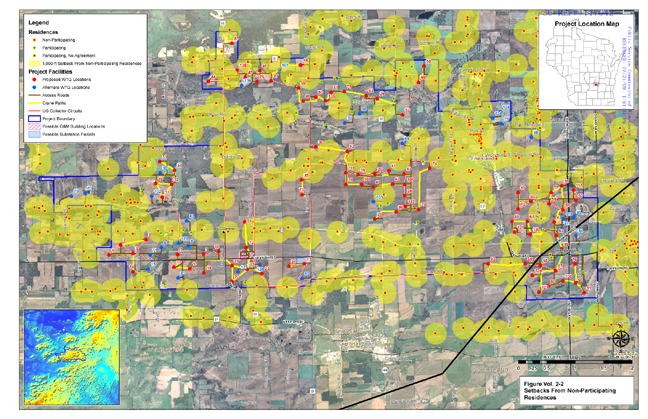“I’m lined up with two turbines that give me a double flicker. You can’t watch TV, you can’t read a book, a newspaper, you can’t work on a computer because your eyes are constantly adjusting to light and dark,” he said. “Green energy is a great thing, but when it interferes with life, health — no, something has to be done.”
- Emmett Curley, wind project resident, January 21, 2011
SOURCE: CBC www.cbc.ca
SUPPORT FOR SENATE BILL 9:
NOTE FROM THE BPWI RESEARCH NERD:
One of the many things Governor Walker's proposed 1800' setback from property lines will do is help protect rural Wisconsin families from having wind turbine shadow flicker forced upon them.
Shadow flicker is downplayed by the wind industry and often mischaracterized by the media as a minor nuisance. Those who live with shadow flicker tell a different story.
PLEASE HELP SUPPORT SENATE BILL 9: WALKER'S WIND SITING REFORM
Better Plan encourages you to take a moment right now to contact Governor Walker's office to thank him for the provisions in Senate Bill 9, (CLICK HERE TO DOWNLOAD THE BILL) which provides for a setback of 1800 feet between wind turbines and property lines.
This setback protects health and safety, protects property values, preserves property rights, gives residents a choice about participating in wind projects planned for their community. Any land owner who wishes to have turbines closer to their property lines may do so by entering into an agreement with the wind company.
CONTACT Governor Scott Walker govgeneral@wisconsin.gov
115 East Capitol
Madison WI 53702
(608) 266-1212
It's also very important that you contact your legislators and encourage them to support the bill.
Who Are My Legislators? To find out, CLICK HERE
Senate | Members | E-Mail Directory
Assembly | Members | E-Mail Directory
What does shadow flicker look like? Click on the image below to see how it affects homes in Fond du Lac County
WIND TURBINE FLICKER UPSETS NEIGHBORS
“I’m lined up with two turbines that give me a double flicker. You can’t watch TV, you can’t read a book, a newspaper, you can’t work on a computer because your eyes are constantly adjusting to light and dark,” he said. “Green energy is a great thing, but when it interferes with life, health — no, something has to be done.”
People living in the shadow of a group of wind turbines in Summerside, P.E.I., are complaining about the flickering light caused by the energy producers.
Emmett Curley has enjoyed living in the area for 15 years, but says things have become unbearable since the wind turbines arrived a year ago.
“Last summer when it started, I left my house. I just couldn’t stand it. I’ve had friends over that left during the situation, saying, ‘I’m starting to get a headache,’” Curley said Friday.
The problem comes when the sun sets and its light passes through the turbines, creating a flickering effect of shadow and light. It lasts for about an hour.
“I’m lined up with two turbines that give me a double flicker. You can’t watch TV, you can’t read a book, a newspaper, you can’t work on a computer because your eyes are constantly adjusting to light and dark,” he said. “Green energy is a great thing, but when it interferes with life, health — no, something has to be done.”
Other neighbours also said they were annoyed by the flickering. One told CBC News that her daughter feels sick to her stomach when it happens and the family has to spend part of their summer evenings in the basement.
Most want the city to shut the turbines off for the hour at sunset when the flicker happens, but the city said that is unlikely.
Greg Gaudet of Summerside Municipal Services said the city could provide options such as shutters or awnings for area residents.
He said shutting down the turbines for an hour each day would cost about $100,000 in lost energy over the course of a year.
“Obviously the city doesn’t want to invest a large amount of money to create renewable energy, which is good for the environment, and then have to reduce those energies,” he said.
“Obviously that’s one of the last solutions the city would look at.”
NOTE FROM THE NERD: EXTRA CREDIT MATH TURBINE RELATED PROBLEM: If $100,000 a year in energy would be lost by shutting down the wind turbine for one hour a day, what would that turbine make in a year? How did you figure it out?
SECOND FEATURE:
HEALTH OFFICIAL FIRES BACK AT GROUP
SOURCE: The London Free Press, www.lfpress.com
January 21 2011
By Jonathan Sher,
A health official who suspects a link between wind turbines and ill health accused a green advocacy group of twisting her words Friday to claim precisely the opposite.
Dr. Hazel Lynn, chief medical officer of health in Huron and Bruce counties, was outraged when the Canadian Association of Physicians for the Environment sent out a media release that suggested she had disavowed the link.
“It’s ridiculous,” said Lynn, who estimates between 10% and 15% of people living near turbines in her area say their health has been affected.
It’s not clear if turbines cause physical harm or stress that brings on poor health, but concerns are real and need to be examined, she said.
“Many people, in many different parts of Grey Bruce and Southwestern Ontario have been dramatically impacted by the noise and proximity of wind farms. To dismiss all these people as eccentric, unusual, or as hyper-sensitive social outliers does a disservice to constructive public discourse and short-circuits our opportunities to learn and benefit from their experiences as we continue to develop new wind farms,” she wrote in a report to her health board.
“It is apparent that a minority of those people living or situated near Industrial Wind Turbines may experience dramatic, negative impacts. We cannot pretend this affected minority doesn’t exist. A determination has to be made as to what level or extent of negative impacts is tolerable.”
Those findings weren’t mentioned by the Canadian Association of Physicians for the Environment when it issued a release that highlighted two lines from Lynn’s seven-page report — that most people don’t complain of ill effects from wind turbines.
“Forty years of science suggests wind turbines do not harm human health,” wrote Gideon Foreman, the group’s executive director. He linked Lynn’s report to a review done last year by Ontario’s chief medical officer of health, a review Lynn publicly objected to because it excluded a section on community harm.
“The study found the scientific literature ‘does not demonstrate a direct causal link between wind turbine noise and adverse health’ effects,’ ” Foreman wrote.

The image above is a detail map of We Energies Glacier Hills project currently under construction in Columbia county. The red squares in yellow circles are the non participating homes in the project. The red dots represent the wind turbines. Below is a small map of the entire project.
The PSC approved the project with setbacks of 1250 feet. The yellow circles below indicate a 1000 foot setback from non-participating homes in the project.

FEATURE OF THE DAY:
NEW STUDY SAYS:
BIG NEW WIND TURBINES TOO CLOSE TOGETHER
January 21, 2010
By Lewis Page
“I believe our results are quite robust,” says Meneveau. “They indicate that large wind farm operators are going to have to space their turbines farther apart.”
Big turbines are at the moment generally installed about seven rotor diameters apart, but Meneveau and Meyers say that the optimum spacing is actually 15 diameters, slightly more than twice as far apart.
If this plan were followed, a wind farm covering a given area would only be able to install a quarter of the number of turbines it could have under today's planning assumptions."
A top American fluid-dynamics boffin says that new, larger wind turbines now going into service are going to have to be placed much further apart - which will have serious implications for the amount of energy produced by wind farms of the future.
The latest wind farms now going into service use huge turbines with rotor diameters in the 100m range, expected to offer large outputs. But according to engineering professor and fluid dynamics expert Charles Meneveau of Johns Hopkins University, there's a problem.
“The early experience is that they are producing less power than expected,” says Meneveau. “Some of these projects are underperforming.”
The prof, who has investigated air flow in wind farms for years, looked into the matter of the underperforming monster turbines along with Johan Meyers of the Katholieke Universiteit Leuven in Belgium.
“I believe our results are quite robust,” says Meneveau. “They indicate that large wind farm operators are going to have to space their turbines farther apart.”
Big turbines are at the moment generally installed about seven rotor diameters apart, but Meneveau and Meyers say that the optimum spacing is actually 15 diameters, slightly more than twice as far apart.
If this plan were followed, a wind farm covering a given area would only be able to install a quarter of the number of turbines it could have under today's planning assumptions. Though the amount of energy generated per turbine would be the best possible, it seems unlikely that such efficiency gains could possibly compensate for the cut in numbers.
On the other hand, if windfarms continue to be constructed with turbines crowded more closely together, they will continue to produce less electricity than their builders had expected.
Overall the professor's research would appear to mean that projected output figures for large new windfarms - for instance the UK's planned, enormous offshore Round 3 facilities, expected to be built in the North Sea from 2015 - will have to be revised downwards one way or another.
Professor Meneveau presented the research, based on wind tunnel studies carried out at Johns Hopkins, at a physics conference recently. The outlines of it are reported in The John Hopkins University Gazette. ®
 EXTRA CREDIT READING:
EXTRA CREDIT READING:
TELL THEM NO:
WHAT DID THE JUDGE SAY TO THE CALIFORNIA PUBLIC UTILITIES COMMISSIONERS ABOUT PACIFIC GAS AND ELECTRIC COMPANY APPLYING TO BUYING A HUGE WIND FARM FROM IBERDROLA?
THE JUDGE DIDN'T THINK IT WAS A GOOD IDEA. HERE IS WHY:
“We reject the application because we find that the Manzana Wind Project is not cost-competitive and poses unacceptable risks to ratepayers.
We find that the proposed cost of the Manzana Wind Project is significantly higher than other resources PG&E can procure to meet its RPS program goal.
Moreover, it will subject the ratepayers to unacceptable risks due to potential cost increases resulting from project under-performance, less than forecasted project life, and any delays which might occur concerning transmission upgrades and commercial online date.
As a proposed utility-owned generation project, ratepayers would pay a lump sum cost rather than a performance based cost for the Manzana Wind Project.
Therefore, ratepayers would be at risk if the project underperforms.
In particular, if the Manzana Wind Project fails to achieve production as expected for any reason such as construction delays or curtailments as a result of a collision with a California condor, shareholders face no risks while customers could incur increased costs"
READ THE ENTIRE STORY BY CLICKING HERE
Visit PG&E's website by clicking here
Visit Iberdrola's website by clicking here
